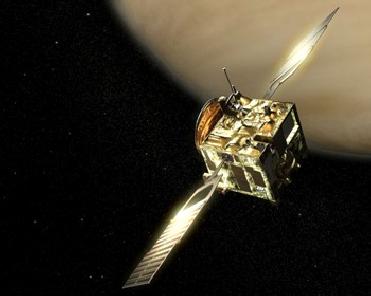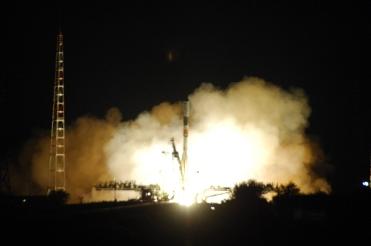
Artist's impression of Venus Express. European Space Agency photo
PARIS (BNS): Discoveries by spacecraft Venus Express has brought planetary scientists closer to understanding the details about the disappearance of water from Venus, which was suspected to be as abundant as on Earth.
The Venus Express made the first detection of an atmospheric loss process on Venus's day-side. Last year, the spacecraft revealed that most of the lost atmosphere escaped from the night-side. In spite of the many discoveries, Venus retains her mystery, said a news release by ESA.
Magda Delva of Austrian Academy of Sciences, Graz, who lead the investigation, said the spacecraft's magnetometer instrument (MAG) detected the unmistakable signature of hydrogen gas being stripped from the day-side.
"This is a process that was believed to be happening at Venus but this is the first time we measured it," he said.
The scientists said Venus Express travels in a highly elliptical path sweeping over the poles of the planet. Water is a key molecule on Earth because it makes life possible. With Earth and Venus approximately the same size, and having formed at the same time, astronomers believe that both planets likely began with similar amounts of the precious liquid.
Today, however, the proportions on each planet are extremely different. Earth's atmosphere and oceans contain 100,000 times the total amount of water on Venus. In spite of the low concentration of water on Venus, Delva and colleagues found that some 2x1024 hydrogen nuclei, a constituent atom of the water molecule, were being lost every second from Venus's day-side.
"Last year, the Analyser of Space Plasma and Energetic Atoms (ASPERA) on board Venus Express showed that there was a great loss of hydrogen and oxygen on the night-side. Roughly twice as many hydrogen atoms as oxygen atoms were escaping. Because water is made of two hydrogen atoms and one oxygen atom, the observed escape indicates that water is being broken up in the atmosphere of Venus," Delva said.
The Sun not only emits light and heat into space, it constantly spews out solar wind, a stream of charged particles. This solar wind carries electrical and magnetic fields throughout the Solar System and 'blows' past the planets, they said.
Unlike Earth, Venus does not generate a magnetic field. This is significant because Earth's magnetic field protects its atmosphere from the solar wind. At Venus, however, the solar wind strikes the upper atmosphere and carries off particles into space. Planetary scientists think that the planet has lost part of its water in this way over the four-and-a-half-thousand million years since the planet's birth.
Stas Barabash, Swedish Institute of Space Physics, Kiruna and Principal Investigator of ASPERA, that looked at night-side data, said that they saw water escaping from the night-side but the question remains, how much had been lost in the past in this way.
The discovery has brought scientists a step towards understanding the details, but it does not provide the last piece of the puzzle. To be certain that the hydrogen is coming from water, Delva and colleagues must also detect the loss of oxygen atoms on the day-side and verify that there are approximately half as many leaving Venus as hydrogen.
So far, this has not been possible. "I keep looking at the magnetometer data but so far I can't see the signature of oxygen escaping on the day-side," Delva said.
It also highlights a new mystery. "These results show that there could be at least twice as much hydrogen in the upper atmosphere of Venus than we thought," he said adding detected hydrogen ions could exist in atmospheric regions high above the surface of the planet; but the source of these regions is unknown.
'First upstream proton cyclotron wave observations at Venus' a research paper has been published in the Geophysical Research Letters. The research has been carried out by M. Delva, T. Zhang, M. Volwerk, W. Magnes, C. Russell and H. Wei.
 Previous Article
Previous Article Next Article
Next Article













The Indian Air Force, in its flight trials evaluation report submitted before the Defence Ministry l..
view articleAn insight into the Medium Multi-Role Combat Aircraft competition...
view articleSky enthusiasts can now spot the International Space Station (ISS) commanded by Indian-American astr..
view article